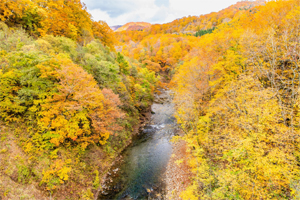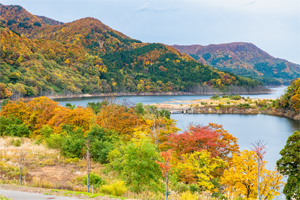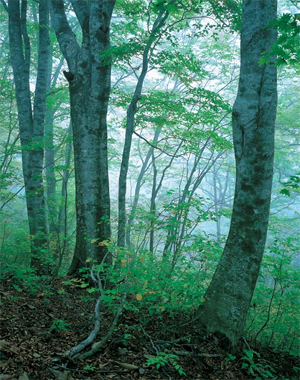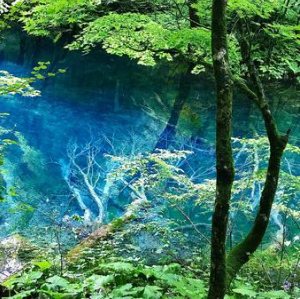

Shirakami Sanchi: A Natural Wonderland
|
Did you know that Japan is home to one of the world’s largest virgin beech forests? Straddling both Akita and Aomori Prefectures, Shirakami Sanchi is a vast mountain range of approximately 130,000 hectares. Within this area, 16,971 hectares is a natural native virgin beech forest, and it was one of the first sites in Japan to be registered as a UNESCO World Heritage site in December 1993. Due to harsh climate conditions, in which snow covers the area for around half a year, there is minimal human impact other than the local Matagi people, who were traditional hunters that lived in harmony with nature.
The forest forms a natural dam that holds water, before it flows to the sea, where the nutrients nurture seafood and algae. This is due to the characteristics of the beech forest. The trees catch the rain, allowing it to eventually flow into the ground. Upon which, the water is slowly filtered over time, and eventually becomes spring water that flows into the river, and sea. The trees also decay over time, and gradually enrich the soil. During the 1970s, there was a proposal for a road to be built across the mountains. However, it was met with opposition as it would mean the loss of invaluable water sources. Eventually, the project was halted. As a result, the forest has been preserved in its primeval state. It is said that the beech forest was fully formed around 8,000 years ago when the ice age ended. The area is almost like a “natural museum” with its rich and diverse ecosystem of animals and plants, many of which are endemic to the region. Examples include plant species such as Silene aomorensis and Ranzania japonica. Considering that the forest has remained untouched by humans, it means that the flora growing there is similar to the ones that would have been found in the Artic Circle about 50 million years ago. As for animals, rare species include the black woodpecker, golden eagle, Japanese serow, and a protected species of dormouse. Preserving the area equates to strict measures taken to monitor and conserve the environment. The beech forest is divided into core and buffer zones. While the core zone can only be entered with permission from Aomori Prefecture, it is strictly prohibited to enter from Akita Prefecture. Meanwhile, patrols are periodically carried out by government agencies and volunteers, to ensure the area is properly conserved. There is also constant monitoring of any effects of global warming and air pollution. As part of efforts to promote ecotourism, school excursions are welcomed, and guided tours are available. The walking trails cover popular spots such as Anmon Falls, a three-tiered waterfall, as well as the famous mystical Aoike Pond. It is also possible to hike to the summit of Mt. Kodake, where you will have a sweeping view of the core zone. When visiting, one should bear in mind to have good hiking etiquette, so as to protect and preserve the precious forest and ecosystem. |
 © Japan Up Close  © Japan Up Close  © Ishibashi Mutsumi, JTB Photo, Sekai Bunka Photo  © photoAC |
Resources
|
“World Heritage in Japan: Shirakami Mountain Range”. 2022. Japan Up Close. https://japanupclose.web-japan.org/spot/s20221021_1.html. “Shirakami-Sanchi – A Beech Forest “Natural Museum””. 2021. Government of Japan. https://www.gov-online.go.jp/eng/publicity/book/hlj/html/202107/202107_02_en.html. “Shirakami-Sanchi”. 2021. Ministry of the Environment. Accessed 18 April. https://www.env.go.jp/nature/isan/worldheritage/en/shirakami/measure/index.html. “About Shirakami Sanchi”. 2024. Akita Shirakami Tourism. Accessed 18 April. https://visitshirakami.com/about/knowledge/. “Venture to Shirakami-Sanchi Mountain Range and the Ancient Beech Forest”. 2024. Japan Airlines. Accessed 18 April.https://www.jal.co.jp/at/en/guide-to-japan/destinations/articles/aomori/shirakami-sanchi.html. “Shirakami Sanchi Mountain Range (UNESCO)”. 2024. Japan National Tourism Organization. Accessed 18 April. https://www.japan.travel/en/world-heritage/shirakami-sanchi-mountain-range/. |
|
Japan Creative Centre 4 Nassim Road, Singapore 258372 +65 6737 0434 / jcc@sn.mofa.go.jp https://www.sg.emb-japan.go.jp/JCC/ Nearest parking at Orchard Hotel & Delphi Orchard |
 |